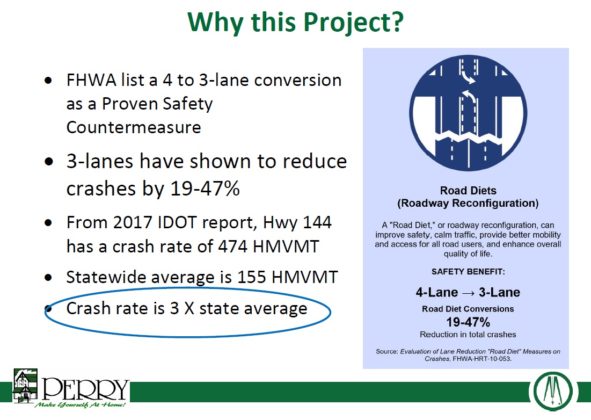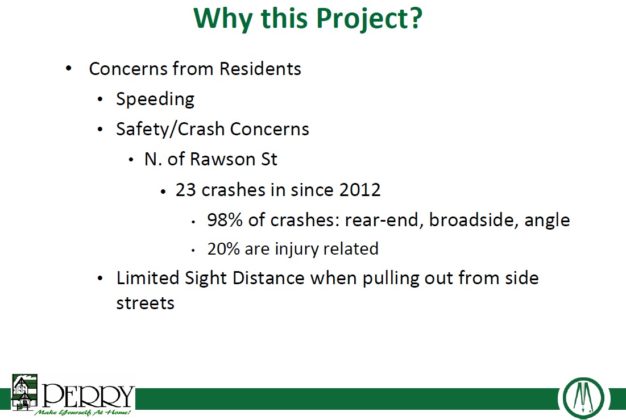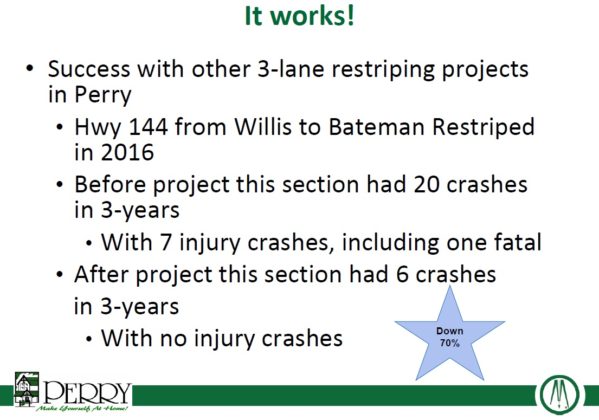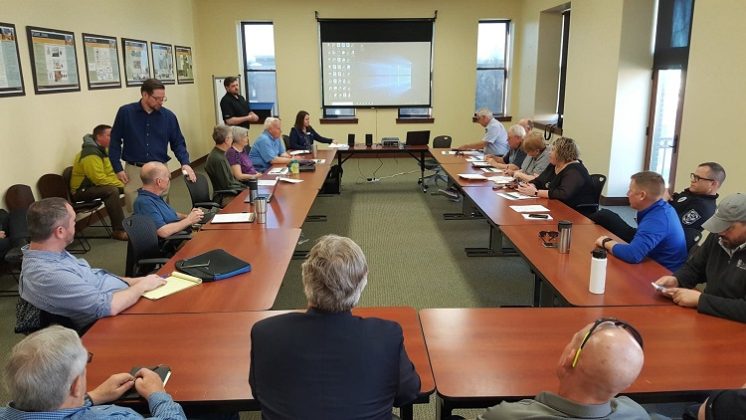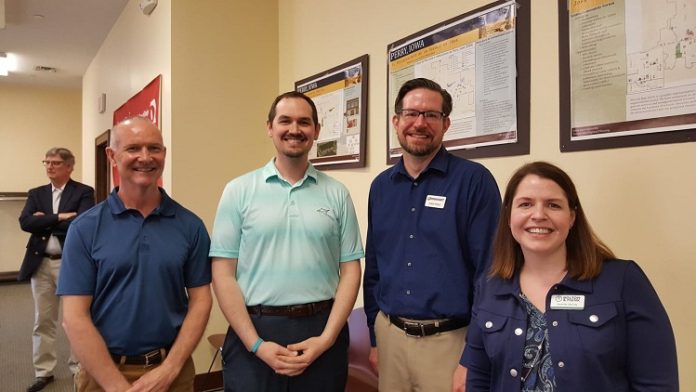
The pros, cons, myths and misconceptions of four-lane-to-three-lane conversions were thoroughly aired Monday morning in the upper room of the Town/Craft Center when the Perry City Council hosted an educational session.
Perry Mayor John Andorf called the meeting to order at 10:30 a.m. The mayor and council were joined by representatives from the city’s public safety and public works departments and by traffic engineers from the Iowa Department of Transportation (DOT) and Bolton and Menck, the city’s engineering consultants.
Bolton and Menk Senior Traffic Engineer Jennifer McCoy facilitated the discussion, opening with a brief DOT video, “4 to 3 Lane Conversions: Roadway Safety in Iowa,” followed by her own detailed presentation on the reasons for putting Iowa Highway 144 (First Avenue) on a “road diet,” which is how transportation planners sometimes refer to four-to-three-lane conversions.
“We’ve actually heard a lot of the different questions and comments,” McCoy said, “whether it’s in ThePerryNews or other places like that.”
McCoy said road diets are among the Federal Highway Administration’s “proven safety countermeasures” — rumble strips and roundabouts are others — and are a relatively low-cost way to improve a roadway’s safety without rebuilding it.
Safety is a significant concern on First Avenue, she said. According to DOT statistics, the Iowa Highway 144 corridor through Perry has a crash rate three times higher than the statewide average for similar undivided four-lane roadways.
McCoy said figures for the 2016 reconfiguration of the intersection of First and Willis avenues — involving First Avenue from Otley Avenue to Bateman Street — already show a 70 percent drop in the crash rate. In the three years prior to redesigning the intersection, there were 20 crashes, including seven injury crashes and one fatality. In the three years since the rebuild, there have been only six crashes, none of which involved injuries.
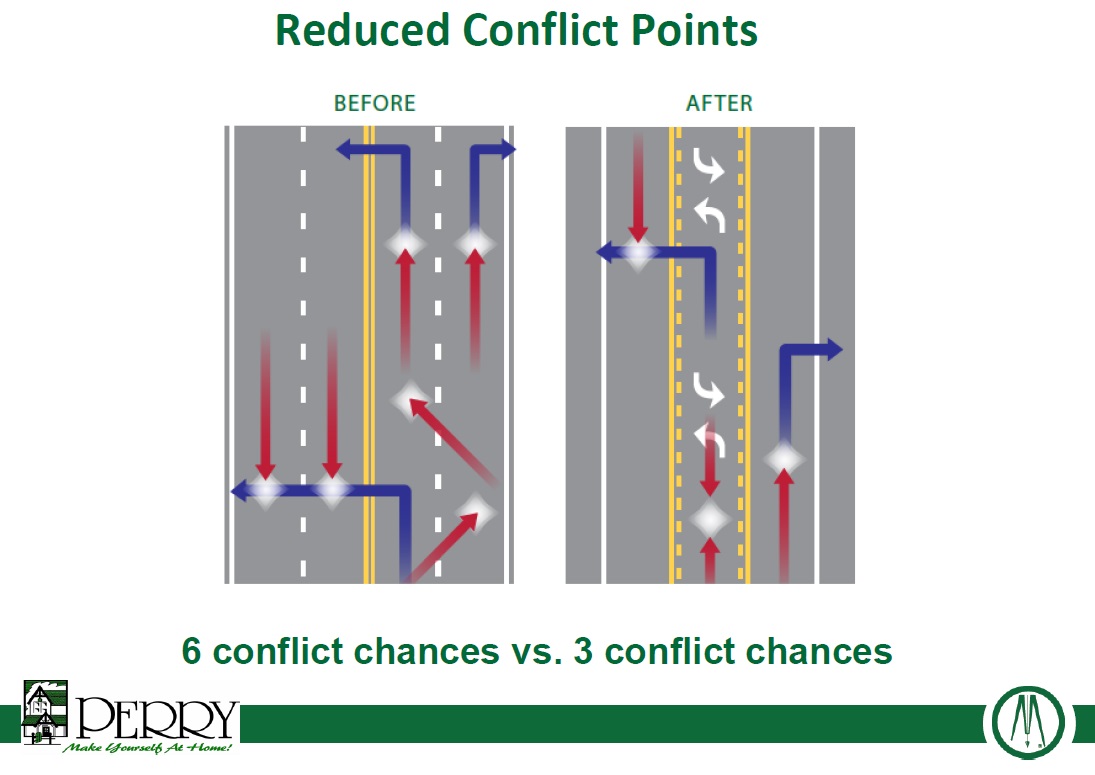
Many readers of ThePerryNews.com made comments opposing the proposed lane conversion when the story appeared on The Perry News Facebook page, but only one community member attended Monday’s meeting in order to speak against the proposal: Charles Stromquist of 2302 First Ave.
Stromquist also came to the council meeting last October when the road-diet plan was first approved. He and Perry City Council member Chuck Schott argued vigorously against the three-lane conversion at Monday’s session, adding some new points to many of the same objections raised last October.
Stromquist was particularly concerned about one of the three conflict points in a three-lane arrangement: the danger a motorist faces in being rear-ended when slowing to make a right turn. This danger is greatest toward the north end of First Avenue, where the speed limit changes to 45 mph and motorists begin to accelerate in anticipation of leaving town.
“There’s a lot of things that’s not being brought up here,” he said. “You keep talking about people turning left, but what about people that turn right? So you’re going to stop or slow down an 80,000-pound truck every time somebody wants to turn right in front of them?”
Stromquist also raised a question about the risks posed by garbage trucks and mail trucks and their effect on a single traffic lane.
“You’re moving all this traffic down to one lane, so you’re creating a parade,” he said. “It’s hard enough to get out there sometimes now with four lanes. You lump all this traffic into two lanes, and in the mornings and afternoons it’s going to be impossible to get on that street in places because of so much traffic.”
DOT Safety Programs Engineer Chris Poole acknowledged Stromquist’s concerns but said he was overstating the risks.
“Honestly,” Poole said, “our crash data just does not support that concern. I understand it’s a concern, especially for you as a resident, but the data just doesn’t play that out. It doesn’t show that.”
Schott praised McCoy’s presentation and said the safety concerns and crash rates were compelling.
“I’ve probably been the leader of the opposition, and I don’t say that proudly, but I say that honestly,” Schott said. “It seems to me like you’re really, really emphasizing everything you can that’s good and hardly ever saying anything about the drawbacks. And I’m sitting here, really trying to be open minded. You’ve said some good things. There’s no doubt about that. You’re telling us that we need to accept driving slower and having slower traffic going past for safety reasons. That’s a concept that quite honestly I hadn’t thought about. Your statistics show that, and I believe your statistics, and I think that’s something that I in particular need to seriously think about.”
Schott also posed a number of what-if cases, such as a stalled or stopped vehicle in the traffic lane, speeders on north First Avenue, excessively slow drivers and the effects of farm equipment and semi-tractor trailers.
The traffic engineers addressed each objection. They said once First Avenue receives an asphalt overlay and the full length of the corridor is made consistent in its lane stripes, confusion will diappear.
“This is something we’ve been doing for over 30 years now — and very successfully, I might add,” Poole said. “We’re approaching 100 cities now that have three-lane roads in them. I think there’s an initial learning curve, especially with certain categories of drivers, younger drivers, older drivers, but that’s more of an enforcement issue than a design issue.”
DOT State Traffic Engineer Supervisor Tim Crouch said three-lane conversions are effective in slowing down the speeders and even speeding up the slow drivers, with the greater uniformity in speed making for a safer roadway.
“Variance of speed is what leads to crashes,” Crouch said, “going different speeds. If you tighten that up, then you improve the safety of the whole corridor by getting rid of that high end and low end.”
Perry City Council member Dr. Randy McCaulley was also graetful for the data provided by the traffic engineers. He said the council’s next step is to make the same information available to Perry residents and others who travel along Iowa Highway 144.
“As a council, we make decisions that we think are in the best interests of the community,” McCaulley said. “Sometimes that may go against the popular opinion out there. This presentation was excellent. I can definitely see the safety benefits in going to a three lane from a four lane. You can’t dispute the data you showed. I think the public is at a disadvantage in not seeing this and knowing this and just offering opinions to whatever council member they see.”
Information sessions will be held this spring and summer to inform the public of the planned safety improvements.








